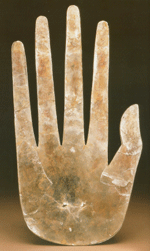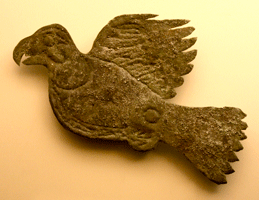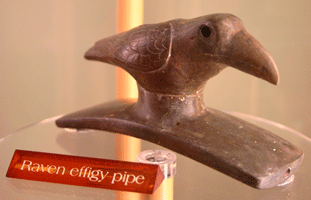|
 This is the Mica Hand created by the Hopewell Culture people, and it was found in Ross County, Ohio, at one of their mound-building sites. It measures 11 inches long by 7 inches wide and was carved out of mica, a silicate with hexagonal crystals that readily cuts into sheets. This is the Mica Hand created by the Hopewell Culture people, and it was found in Ross County, Ohio, at one of their mound-building sites. It measures 11 inches long by 7 inches wide and was carved out of mica, a silicate with hexagonal crystals that readily cuts into sheets.
The mica used for carving the Hand has been traced to mica deposits in North Carolina. The Hopewell Culture was not one homogenous group of people but rather at least 22 groups of people related by trade and interaction. The locations of these groups have been mapped out as the “Hopewell Interaction Sphere”; they inhabited parts of more than 20 states in the central and mid-western U.S. (including the eastern parts of Missouri, Iowa, Oklahoma and down to Texas), the southern states and along the Gulf Coast and northern Florida, and parts of the northeastern states and southern Canada. That covers a lot of ground even in our day, let alone by foot in those days, which was from about 200 B.C. to 500 A.D.
Archaeologists have discovered no written records left by them so the Hopewell Culture was so-named for the owners of the farm where their mounds were excavated in Ross County, Ohio.
Many Hopewell Culture groups built mounds and earthworks, some with astronomical relationships. Archaeologists have not definitely confirmed the purposes of the mounds, but some writers have called them “cathedrals” or other such edifices because of their great magnitude in size and for the artifacts found in or near them—some of which are postulated to have been religious offerings. Copper tools, copper animal effigies, seashells, obsidian arrow points (traced to Yellowstone in Montana), pots with incised designs, carved pipes, mica carvings of animals, and the Mica Hand are just a few of the Hopewell artifacts. The great distances traveled to bring these items to the earthwork structures for more than just trade suggests pilgrimages.
The sheer size of the earthwork structures and the effort required to construct them also lends to the belief that they were built for religious or ceremonial purposes. The Newark Hopewell earthwork structures in Ohio are huge, situated on 4.5 square miles of land. The structures include a circle 1,200 feet in diameter, another large circle, a hexagon, a square, a semi-circle, and long parallel lines of earthwork walls leading from one shaped structure to another.1 The Newark earthworks are the largest in the world, and they were all painstakingly constructed using rudimentary tools to fill baskets with dirt.
|

|

|
|
A Hopewell Culture copper bird made from beaten copper sheets held in the American Museum of Natural History, New York. (Photo, courtesy of Uyvsdi.)
|
A carved raven effigy pipe in the Hopewell Culture National Historical Park Museum.
(Photo, courtesy of Dmitri Lytov.)
|
About 500 A.D., the Hopewell Cultures quit building mounds, their trading and pilgrimage networks broke down, and their artwork ceased. The period following is known as the Late Woodland Period when larger villages with fortified walls replaced smaller villages. This suggests war may have been a cause for the loss of or change in the Hopewell Cultures.
The Mica Hand was identified by Ted Carlton of Utah, and Sherron Lawson of Roswell, Ga.
------------------------------------
1
C-span.org, “Newark Earthworks,” July 9, 2012.
|